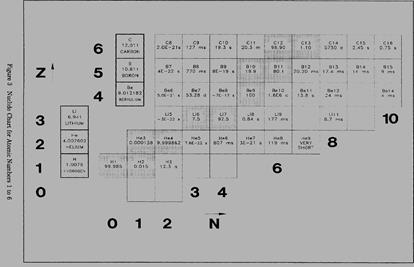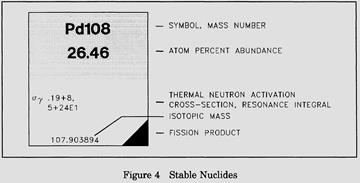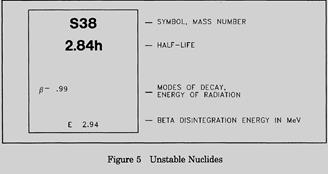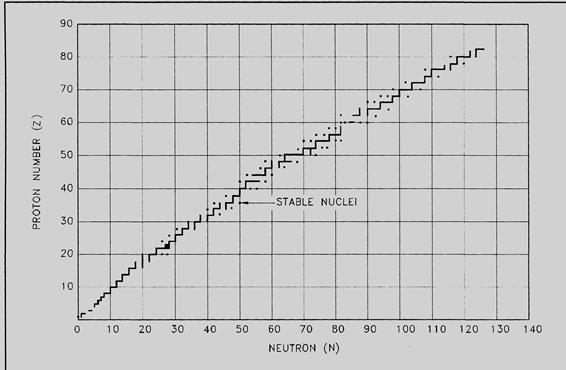Match the notions and their definitions
| 1. Nuclide | a) is a property of several naturally occurring elements as well as of artificially produced isotopes of the elements. |
| 2. Isomer | b) species of atom as characterized by the number of protons, the number of neutrons, and the energy state of the nucleus. |
| 3. Radioactive decay | c) the rate at which a radioactive element decays is expressed. |
| 4. Half-life | d) any of two or more nuclides (species of atomic nuclei) that consists of the same number of protons and the same number of neutrons but differ in energy and manner of radioactive decay, and that exist for a measurable interval of time. |
Work in pairs. Complete the table below.
| Element | Atomic number | Atomic weight | Melting point | Boiling point | Specific gravity | Valence | Electronic config. |
| sodium | |||||||
| chlorine | |||||||
| uranium | |||||||
| plutonium |
1.4. Translate the sentences and mind the form of the Infinitive after "must" and "may".
Example:
He must be hungry after his long walk. Он, должно быть, голоден...
He must have been hungry after his long walk yesterday. Он, должно быть, был голоден...
1. This term must be a confusing one, it has several meanings.
2. He must have attempted to make his description concise and accurate, but failed.
3. These instructions must have been executed simultaneously.
4. There must be some incompatibility of the results since he has not adjusted the installation properly.
5. There must have been a slight ambiguity in your explanation, that's why you were asked so many questions.
Example:
He may arrive any moment.
Он может появиться... (Он, вероятно появится...)
He may have arrived already, let's go and find out. Он, вероятно, появился...
1.Your suggestion may be very advantageous but it will hardly be accepted.
2. I am not saying: "You were mistaken."' I am saying: "You may have been mistaken."
3.This similarity is of interest for it may provide an alternative characteristic of the system.
4. Numerous auxiliary means may have been available at that time.
5. The electrical conductivity in this region may have been negligible since the temperature in the vicinity of this region was maintained low.
6. Along with a list of possible attractive characteristics of this device there may be apparent drawbacks.
Make up a report on the topics below.
1.«Sodium»
2.«Chlorine»
3.«Uranium»
4. «Plutonium»
(See appendix 4)
TEXT 2
Before reading the following text, work with a partner and discuss the questions below. Base your answers on your possible knowledge of the topic. Then read the text and check your guesses.
1.What is a chart of the nuclides?
2. What does a typical block for a stable nuclide contain?
3. What does a typical block for an unstable nuclide contain?
Chart of the Nuclides
The Chart of the Nuclides, like the Periodic Table, is a convenient format for presenting a large amount of scientific information in an organized manner.
A tabulated chart called the Chart of the Nuclides lists the stable and unstable nuclides in addition to pertinent information about each one. Figure 3 shows a small portion of a typical chart. This chart plots a box for each individual nuclide, with the number of protons (Z) on the vertical axis and the number of neutrons (N = A - Z) on the horizontal axis.
The completely gray squares indicate stable isotopes. Those in white squares are artificially radioactive, meaning that they are produced by artificial techniques and do not occur naturally. By consulting a complete chart, other types of isotopes can be found, such as naturally occurring radioactive types (but none are found in the region of the chart that is illustrated in Figure 3).
Located in the box on the far left of each horizontal row is general information about the element. The box contains the chemical symbol of the element in addition to the average atomic weight of the naturally occurring substance and the average thermal neutron absorption cross section, which will be discussed in a later module. The known isotopes (elements with the same atomic number Z but different mass number A) of each element are  listed to the right.
listed to the right.

For the stable isotopes, in addition to the symbol and the atomic mass number, the number percentage of each isotope in the naturally occurring element is listed, as well as the thermal neutron activation cross section and the mass in atomic mass units (amu). A typical block for a stable nuclide from the Chart of the Nuclides is shown in Figure 4.

 For unstable isotopes the additional information includes the half life, the mode of decay (for example, β, α), the total disintegration energy in MeV (million electron volts), and the mass in amu when available. A typical block for an unstable nuclide from the Chart of the Nuclides is shown in Figure 5.
For unstable isotopes the additional information includes the half life, the mode of decay (for example, β, α), the total disintegration energy in MeV (million electron volts), and the mass in amu when available. A typical block for an unstable nuclide from the Chart of the Nuclides is shown in Figure 5.
2.2. Fill in the gaps (1-6) with the words from the box below the text. There is one extra word which you don’t need to use.
Figure 6 shows the distribution of the stable nuclides plotted on the same 1__________ as the Chart of the Nuclides. As the 2__________ become higher, the ratio of neutrons to protons in the nucleus becomes larger. For helium-4 (2 protons and 2 neutrons) and oxygen-16 (8 protons and 8 neutrons) this ratio is unity. For indium-115 (49 protons and 66 neutrons) the ratio of neutrons to protons has increased to 1.35, and for uranium-238 (92 protons and 146 neutrons) the neutron-to-proton ratio is 1.59.

If a heavy nucleus were to split into two fragments, each fragment would form a nucleus that would have approximately the same 3__________ ratio as the heavy nucleus. This high neutron-to-proton ratio places the fragments below and to the right of the 4__________ displayed by Figure 6. The instability caused by this 5__________ of neutrons is generally rectified by successive beta emissions, each of which converts a neutron to a 6__________ and moves the nucleus toward a more stable neutron-to-proton ratio.
